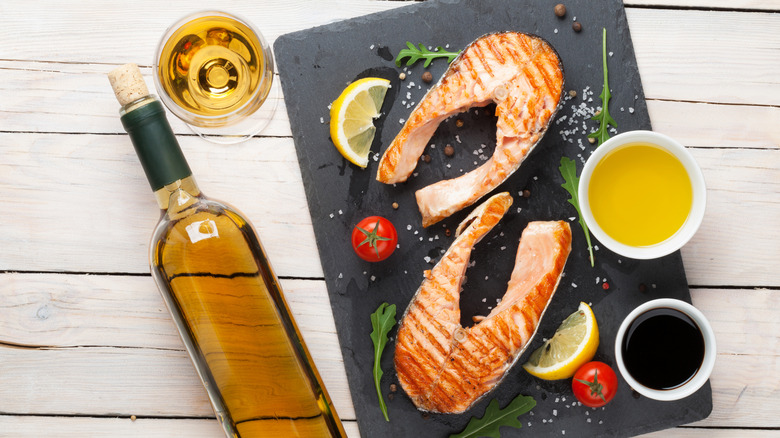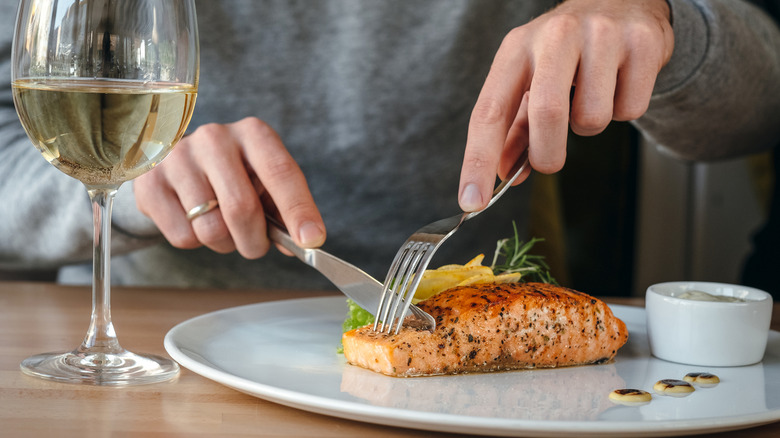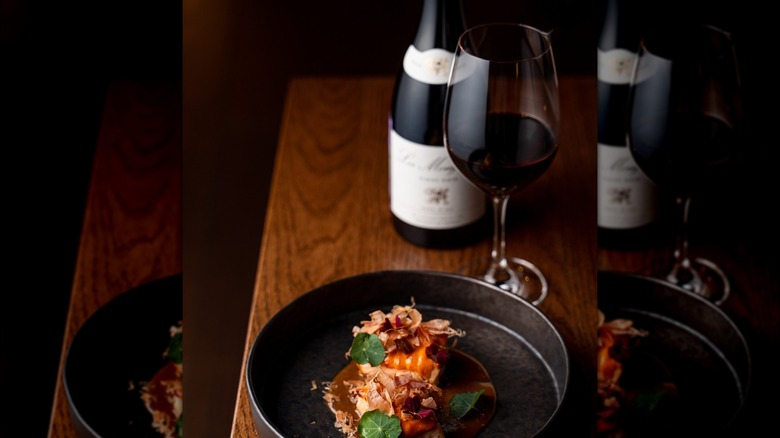The Basic Rule For Pairing Wine With Salmon
There was a time when food lovers, pro chefs, and food critics alike held a long-standing belief that fish could only be paired with white wines. Then, in 1989, Joshua Wesson and David Rosengarten debuted their book "Red Wine With Fish: The New Art of Matching Wine With Food," which opened the door to pairing seafood with red wine. In 1992, The New York Times issued an article with a similar sentiment, and suggested California Cabernet Sauvignon and Bordeaux as fantastic choices to serve with grilled salmon.
Has the white wine-with-fish wine rule been completely obliterated? Not necessarily. In fact, a full-bodied white wine still may be your best choice for serving with salmon, but it all depends on the preparation. Salmon is a dynamic-tasting and delicious fish that is very rich and full of good, heart-healthy fatty acids, but the flavor itself is delicate (unless it's smoked to make its salty and fishy flavors more prominent). This is why you might want to tread carefully around bold red wines, while white wines remain a solid choice.
The cooking method and any accompanying ingredients can affect the way a wine complements a salmon dish. When all is said and done, drink what you like, but our tips for pairing your favorite salmon recipes with the right wine are a good start for home cooks who may be unsure.
You can't go wrong with a full-bodied white wine
A simple, roasted, lightly-seasoned filet of salmon will shine when paired with a white wine that's more full-bodied. This also applies to baked or poached salmon. These types of white wines are sometimes described as feeling heavy and rich in the mouth. A wine's alcohol content can also determine its body, with full-bodied wines generally containing at least 13.5% alcohol. Some good full-bodied whites to try with salmon include Chardonnay (those that are aged in oak barrels as opposed to steel tanks), Viognier, Sémillon, and Chenin Blanc. Many of these bottles have buttery, nutty, and toasty notes with tropical fruit and vanilla essences.
When your salmon is simply seasoned with no bold spices or condiments, these wines can actually add flavor to the fish, creating a fun and delicious dining experience. Richer types of white wines act as congruent pairings (being similar to the salmon itself) as opposed to complementary pairings (another term for contrasting flavors). In a nutshell, congruent wine pairings match the character of the food, while a complementary pairing would act as a foil. A sharp, acidic sparkling wine would cut the fattiness of the oily fish, as opposed to a buttery Chardonnay, which echoes it.
Wine pairings can vary based on preparation
As tasty as an uncomplicated filet of salmon can be, most restaurants will serve their salmon with a sauce, glaze, or with a layer of irresistible crispy skin. Depending on the preparation, exploring bottles outside of the white wine list can be a good idea. Seared or grilled salmon is wonderful with a light, fruity Pinot Noir. Other good options are French Beaujolais and Valpolicella, as long as the specific bottles have light tannins. A red wine that is too bold could make the salmon taste metallic.
If your salmon comes with a good amount of crispy skin, try a rosé (which is one of the most food-friendly categories of wines you can drink) or a subtly sweet, bubbly Italian Lambrusco. Meanwhile, smoked salmon has a much fishier flavor than fresh salmon, and you'll want something to offset the strong, salty flavor, so try a rosé (either still or sparkling) or even a Syrah, if the dominant flavor of your fish is more smoky than salty.
Salmon with lots of fresh herbs would be lovely with Sauvignon Blanc, while a spicier preparation would shine with a wine with some sweetness, like a German Riesling. And don't be afraid to go after the previously mentioned acidic wines to cut through a very fatty filet. Salmon might be one of the most versatile foods you can choose for wine pairing, making the adventure of finding its perfect partner that much more exciting.



